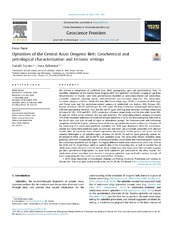| dc.description.abstract | We present a compilation of published data (field, petrography, ages and geochemistry) from 73 ophiolitic complexes of the Central Asian Orogenic Belt. The ophiolitic complexes, ranging in age from Neoproterozoic to Triassic, have been geochemically classified as subduction-related and subduction-unrelated categories applying recent, well-established discrimination diagrams. The subduction-unrelated category is further subdivided into Mid-Ocean Ridge type (MOR), a common rift-drift stage and Plume type, and the subduction-related category is subdivided into Backarc (BA), Forearc (FA), Backarc to Forearc (BA-FA) and Volcanic Arc (VA) types. The four subduction-related types define highly different geochemical features, with the BA and FA types defining end members showing subduction influence of 10%–100% and 90%–100% subduction influence, respectively, and the two other types (BA-FA and VA) define values between the two end members. The subduction-related category comprises 79% of the examined ophiolites, of which the BA type ophiolites is by far the dominant group, followed by the BA-FA type, and with FA and VA types as subordinate groups. The Neoproterozoic and Ordovician complexes exhibit the highest, whereas those of Silurian age exhibit the lowest subduction-influence. Of the remaining 21% subduction-unrelated ophiolites, the MOR type dominates. Both the subduction-related and subduction-unrelated types, in particular the latter, are commonly associated with alkaline basalts taken to represent ocean island magmatism. Harzburgite, dunite, gabbro and basalt are the common lithologies in all ophiolite types, whereas the BA-FA, FA and VA types generally contain intermediate to felsic rocks, and in the FA type boninites occur. The subduction-related ophiolites types generally show low metamorphic grade, whereas greenschist, amphibolite and blueschist grades occur in the subduction-unrelated and BA types. The highly different subduction contribution (from 0 to 100% in the MOR and FA, respectively), attest to variable dips of the subducting slab, as well as variable flux of subduction-related elements into the mantle above subducting slabs, from where the ophiolite magmas got their geochemical fingerprints. As most MOR ophiolites get subducted to the deep mantle, the subduction-related ophiolites have become a dominant ophiolitic type on Earth's surface through all times supporting the idea about the early start of Plate Tectonics. | en_US |
